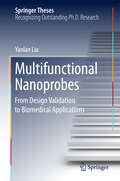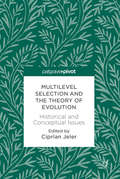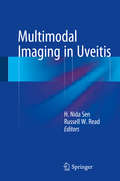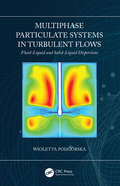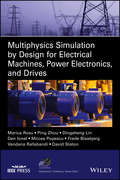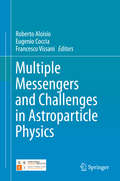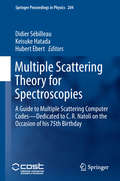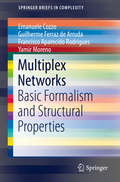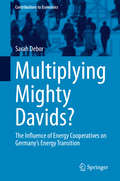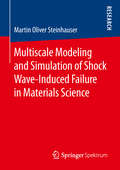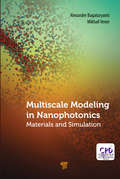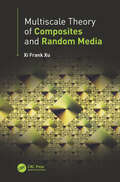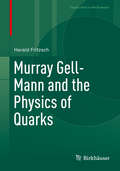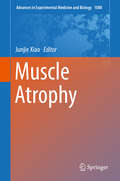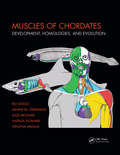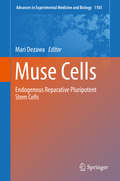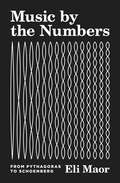- Table View
- List View
Multifunctional Nanoprobes: From Design Validation to Biomedical Applications (Springer Theses)
by Yanlan LiuThis thesis mainly focuses on the design and synthesis of novel multifunctional nanoprobes, investigating their feasibility for applications involving sensing, molecular imaging, and the simultaneous diagnosis and therapy of cancer. Above all, it discusses the development of innovative nanomaterials to address the issues limiting the effectiveness of currently available nanoprobes such as the synthesis shortcoming and poor performance in sensing, imaging and therapeutic applications. One of the strengths of this thesis is its integration of knowledge from chemistry, materials science and biomedicine. Further, it presents the theoretical fundamentals in the design of nanoprobes, which can offer guidance for future studies on the development of novel multifunctional nanomaterials with significantly enhanced performance.
Multifunctional Wetlands: Pollution Abatement and Other Ecological Services from Natural and Constructed Wetlands (Environmental Contamination Remediation and Management)
by Nidhi Nagabhatla Christopher D. MetcalfeThis book describes how natural or constructed wetlands can be used to reduce pollution of freshwater and coastal ecosystems, while still preserving their biodiversity and ecological functions. Through a series of case histories described in 10 chapters in the monograph, the readers will gain an understanding of the opportunities, as well as the challenges associated with reducing point and non-point source pollution using natural, restored or constructed wetlands. The target audience will be water practitioners involved in projects utilizing integrated watershed management approaches to pollution abatement, as well as researchers who are designing projects focused on this topic.
Multilevel Selection and the Theory of Evolution: Historical And Conceptual Issues
by Ciprian JelerThis book puts multilevel selection theory into a much needed historical perspective. This is achieved by discussing multilevel selection in the first half of the twentieth century, the reasons for the energetic rejection of Wynne-Edwards’ group selectionist stance in the 1960s, Elisabeth Lloyd’s contribution to the units of selection debate, Price’s hierarchical equation and its possible interpretations and, finally, species selection in macroevolutionary contexts. Another idea also seems to emerge from these studies; namely, that perhaps a more sure-footed position for multilevel selection theory would be acquired if we were to show a renewed interest in 'old group selection', i.e. in scenarios in which the differential reproduction of the groups themselves affects the frequencies of either individual-level or group-level traits. This book will be of interest to philosophers and historians of biology, as well as to theoretically inclined biologists who have an interest in multilevel selection theory.
Multilevel Selection and the Theory of Evolution (PDF)
by Ciprian JelerThis book puts multilevel selection theory into a much needed historical perspective. This is achieved by discussing multilevel selection in the first half of the twentieth century, the reasons for the energetic rejection of Wynne-Edwards’ group selectionist stance in the 1960s, Elisabeth Lloyd’s contribution to the units of selection debate, Price’s hierarchical equation and its possible interpretations and, finally, species selection in macroevolutionary contexts. Another idea also seems to emerge from these studies; namely, that perhaps a more sure-footed position for multilevel selection theory would be acquired if we were to show a renewed interest in 'old group selection', i.e. in scenarios in which the differential reproduction of the groups themselves affects the frequencies of either individual-level or group-level traits. This book will be of interest to philosophers and historians of biology, as well as to theoretically inclined biologists who have an interest in multilevel selection theory.
Multimodal Imaging in Uveitis
by H. Nida Sen Russell W. ReadThis book is a comprehensive guide to the imaging techniques that have revolutionized the diagnosis and management of uveitis during the past decade, including optical coherence tomography (OCT), enhanced depth imaging, fundus autofluorescence, and wide-field angiography. In addition, the current role of the traditional (invasive) gold standard techniques, fluorescein angiography and indocyanine green angiography, is described. Among the newer imaging modalities, detailed attention is paid to the various OCT technologies such as spectral domain OCT, enhanced-depth imaging OCT, and enface swept-source OCT. Further individual chapters focus on imaging using adaptive optics, multiview OCT, and OCT angiography.Uveitis can affect virtually any structure in the eye, and imaging of these structures is critical in the diagnosis, prognosis, and management of the disease. Increasing use and better understanding of the different modalities described in this book are sure to improve our knowledge of disease mechanisms and likely outcomes.
Multiphase Particulate Systems in Turbulent Flows: Fluid-Liquid and Solid-Liquid Dispersions
by Wioletta PodgórskaMultiphase Particulate Systems in Turbulent Flows: Fluid-Liquid and Solid-Liquid Dispersions provides methods necessary to analyze complex particulate systems and related phenomena including physical, chemical and mathematical description of fundamental processes influencing crystal size and shape, suspension rheology, interfacial area of drops and bubbles in extractors and bubble columns. Examples of mathematical model formulation for different processes taking place in such systems is shown. Discussing connections between turbulent mixing mechanisms and precipitation, it discusses influence of fine-scale structure of turbulence, including its intermittent character, on breakage of drops, bubbles, cells, plant cell aggregates. An important aspect of the mathematical modeling presented in the book is multi-fractal, taking into account the influence of internal intermittency on different phenomena. Key Features Provides detailed descriptions of dispersion processes in turbulent flow, interactions between dispersed entities, and continuous phase in a single volume Includes simulation models and validation experiments for liquid-liquid, gas-liquid, and solid-liquid dispersions in turbulent flows Helps reader learn formulation of mathematical models of breakage or aggregation processes using multifractal theory Explains how to solve different forms of population balance equations Presents a combination of theoretical and engineering approaches to particulate systems along with discussion of related diversity, with exercises and case studies
Multiphase Particulate Systems in Turbulent Flows: Fluid-Liquid and Solid-Liquid Dispersions
by Wioletta PodgórskaMultiphase Particulate Systems in Turbulent Flows: Fluid-Liquid and Solid-Liquid Dispersions provides methods necessary to analyze complex particulate systems and related phenomena including physical, chemical and mathematical description of fundamental processes influencing crystal size and shape, suspension rheology, interfacial area of drops and bubbles in extractors and bubble columns. Examples of mathematical model formulation for different processes taking place in such systems is shown. Discussing connections between turbulent mixing mechanisms and precipitation, it discusses influence of fine-scale structure of turbulence, including its intermittent character, on breakage of drops, bubbles, cells, plant cell aggregates. An important aspect of the mathematical modeling presented in the book is multi-fractal, taking into account the influence of internal intermittency on different phenomena. Key Features Provides detailed descriptions of dispersion processes in turbulent flow, interactions between dispersed entities, and continuous phase in a single volume Includes simulation models and validation experiments for liquid-liquid, gas-liquid, and solid-liquid dispersions in turbulent flows Helps reader learn formulation of mathematical models of breakage or aggregation processes using multifractal theory Explains how to solve different forms of population balance equations Presents a combination of theoretical and engineering approaches to particulate systems along with discussion of related diversity, with exercises and case studies
Multiphysics Simulation by Design for Electrical Machines, Power Electronics and Drives (IEEE Press Series on Power Engineering)
by Dr. Marius Rosu Dr. Ping Zhou Dr. Dingsheng Lin Dr. Dan M. Ionel Dr. Mircea Popescu Frede Blaabjerg Dr. Vandana Rallabandi Dr. David StatonPresents applied theory and advanced simulation techniques for electric machines and drives This book combines the knowledge of experts from both academia and the software industry to present theories of multiphysics simulation by design for electrical machines, power electronics, and drives. The comprehensive design approach described within supports new applications required by technologies sustaining high drive efficiency. The highlighted framework considers the electric machine at the heart of the entire electric drive. The book also emphasizes the simulation by design concept—a concept that frames the entire highlighted design methodology, which is described and illustrated by various advanced simulation technologies. Multiphysics Simulation by Design for Electrical Machines, Power Electronics and Drives begins with the basics of electrical machine design and manufacturing tolerances. It also discusses fundamental aspects of the state of the art design process and includes examples from industrial practice. It explains FEM-based analysis techniques for electrical machine design—providing details on how it can be employed in ANSYS Maxwell software. In addition, the book covers advanced magnetic material modeling capabilities employed in numerical computation; thermal analysis; automated optimization for electric machines; and power electronics and drive systems. This valuable resource: Delivers the multi-physics know-how based on practical electric machine design methodologies Provides an extensive overview of electric machine design optimization and its integration with power electronics and drives Incorporates case studies from industrial practice and research and development projects Multiphysics Simulation by Design for Electrical Machines, Power Electronics and Drives is an incredibly helpful book for design engineers, application and system engineers, and technical professionals. It will also benefit graduate engineering students with a strong interest in electric machines and drives.
Multiphysics Simulation by Design for Electrical Machines, Power Electronics and Drives (IEEE Press Series on Power Engineering)
by Dr. Marius Rosu Dr. Ping Zhou Dr. Dingsheng Lin Dr. Dan M. Ionel Dr. Mircea Popescu Frede Blaabjerg Dr. Vandana Rallabandi Dr. David StatonPresents applied theory and advanced simulation techniques for electric machines and drives This book combines the knowledge of experts from both academia and the software industry to present theories of multiphysics simulation by design for electrical machines, power electronics, and drives. The comprehensive design approach described within supports new applications required by technologies sustaining high drive efficiency. The highlighted framework considers the electric machine at the heart of the entire electric drive. The book also emphasizes the simulation by design concept—a concept that frames the entire highlighted design methodology, which is described and illustrated by various advanced simulation technologies. Multiphysics Simulation by Design for Electrical Machines, Power Electronics and Drives begins with the basics of electrical machine design and manufacturing tolerances. It also discusses fundamental aspects of the state of the art design process and includes examples from industrial practice. It explains FEM-based analysis techniques for electrical machine design—providing details on how it can be employed in ANSYS Maxwell software. In addition, the book covers advanced magnetic material modeling capabilities employed in numerical computation; thermal analysis; automated optimization for electric machines; and power electronics and drive systems. This valuable resource: Delivers the multi-physics know-how based on practical electric machine design methodologies Provides an extensive overview of electric machine design optimization and its integration with power electronics and drives Incorporates case studies from industrial practice and research and development projects Multiphysics Simulation by Design for Electrical Machines, Power Electronics and Drives is an incredibly helpful book for design engineers, application and system engineers, and technical professionals. It will also benefit graduate engineering students with a strong interest in electric machines and drives.
Multiple Messengers and Challenges in Astroparticle Physics
by Roberto Aloisio Eugenio Coccia Francesco VissaniThis book, designed as a tool for young researchers and graduate students, reviews the main open problems and research lines in various fields of astroparticle physics: cosmic rays, gamma rays, neutrinos, cosmology, and gravitational physics. The opening section discusses cosmic rays of both galactic and extragalactic origin, examining experimental results, theoretical models, and possible future developments. The basics of gamma-ray astronomy are then described, including the detection methods and techniques. Galactic and extragalactic aspects of the field are addressed in the light of recent discoveries with space-borne and ground-based detectors. The review of neutrinos outlines the status of the investigations of neutrino radiation and brings together relevant formulae, estimations, and background information. Three complementary issues in cosmology are examined: observable predictions of inflation in the early universe, effects of dark energy/modified gravity in the large-scale structure of the universe, and neutrinos in cosmology and large-scale structures. The closing section on gravitational physics reviews issues relating to quantum gravity, atomic precision tests, space-based experiments, the strong field regime, gravitational waves, multi-messengers, and alternative theories of gravity.
Multiple Scattering Theory for Spectroscopies: A Guide to Multiple Scattering Computer Codes -- Dedicated to C. R. Natoli on the Occasion of his 75th Birthday (Springer Proceedings in Physics #204)
by Didier Sébilleau Keisuke Hatada Hubert EbertThis edited book, based on material presented at the EU Spec Training School on Multiple Scattering Codes and the following MSNano Conference, is divided into two distinct parts. The first part, subtitled “basic knowledge”, provides the basics of the multiple scattering description in spectroscopies, enabling readers to understand the physics behind the various multiple scattering codes available for modelling spectroscopies. The second part, “extended knowledge”, presents “state- of-the-art” short chapters on specific subjects associated with improving of the actual description of spectroscopies within the multiple scattering formalism, such as inelastic processes, or precise examples of modelling.
Multiplex Networks: Basic Formalism and Structural Properties (SpringerBriefs in Complexity)
by Emanuele Cozzo Guilherme Ferraz de Arruda Francisco Aparecido Rodrigues Yamir MorenoThis book provides the basis of a formal language and explores its possibilities in the characterization of multiplex networks. Armed with the formalism developed, the authors define structural metrics for multiplex networks. A methodology to generalize monoplex structural metrics to multiplex networks is also presented so that the reader will be able to generalize other metrics of interest in a systematic way. Therefore, this book will serve as a guide for the theoretical development of new multiplex metrics. Furthermore, this Brief describes the spectral properties of these networks in relation to concepts from algebraic graph theory and the theory of matrix polynomials. The text is rounded off by analyzing the different structural transitions present in multiplex systems as well as by a brief overview of some representative dynamical processes. Multiplex Networks will appeal to students, researchers, and professionals within the fields of network science, graph theory, and data science.
Multiplying Mighty Davids?: The Influence of Energy Cooperatives on Germany's Energy Transition (Contributions to Economics)
by Sarah DeborThis book systematically describes and evaluates the impact of energy cooperatives as a key driving force in the German energy transition toward a sustainability-oriented energy sector. Based on a comprehensive survey and three case studies, it provides an instructive overview of the overall dimensions and scope of energy cooperatives in Germany, and of their history, structure and current investment projects. The book not only contributes to the energy policy discourse in Germany, but also highlights the role of energy cooperatives to enable an international readership to explore their potential in other countries. Further, it makes a theoretical contribution toward substantially supplementing actor research in general, and enterprise research in particular, in the field of sustainability transitions science.
Multiscale Modeling and Simulation of Shock Wave-Induced Failure in Materials Science
by Martin Oliver SteinhauserMartin Oliver Steinhauser deals with several aspects of multiscale materials modeling and simulation in applied materials research and fundamental science. He covers various multiscale modeling approaches for high-performance ceramics, biological bilayer membranes, semi-flexible polymers, and human cancer cells. He demonstrates that the physics of shock waves, i.e., the investigation of material behavior at high strain rates and of material failure, has grown to become an important interdisciplinary field of research on its own. At the same time, progress in computer hardware and software development has boosted new ideas in multiscale modeling and simulation. Hence, bridging the length and time scales in a theoretical-numerical description of materials has become a prime challenge in science and technology.
Multiscale Modeling in Nanophotonics: Materials and Simulations
by Alexander Bagaturyants Mikhail VenerThe idea of theoretically predicting the useful properties of various materials using multiscale simulations has become popular in recent years. Of special interest are nanostructured, organic functional materials, which have a hierarchical structure and are considered materials of the future because of their flexibility and versatility. Their functional properties are inherited from the molecule that lies at the heart of the hierarchical structure. On the other hand, the properties of this functional molecule, in particular its absorption and emission spectra, strongly depend on its interactions with its molecular environment. Therefore, the multiscale simulations used to predict the properties of organic functional materials should be atomistic, that is, they should be based on classical and/or quantum methods that explicitly take into account the molecular structure and intermolecular interactions at the atomic level. This book, written by well-known specialists in theoretical chemistry, focuses on the basics of classical mechanics, quantum chemistry methods used for molecular disordered materials, classical methods of molecular simulations of disordered materials, vibronic interactions, and applications (presented as multiscale strategies for atomistic simulations of photonic materials). It has been edited by Professor Mikhail Alfimov, a renowned Russian scientist, a full member of the Russian Academy of Sciences, Russia, and the founder, first director, and now research supervisor of the Photochemistry Center of the Russian Academy of Science, Russia. Professor Alfimov’s main research interests are in the field of photochemistry and photophysics of molecular and supramolecular systems. The book is a great reference for advanced undergraduate- and graduate-level students of nanotechnology and molecular science and researchers in nano- and molecular science, nanotechnology, chemistry, and physical chemistry, especially those with an interest in functional materials.
Multiscale Theory of Composites and Random Media
by Xi Frank XuThis is the first book to introduce Green-function-based multiscale theory and the corresponding finite element method, which are readily applicable to composites and random media. The methodology is considered to be the one that most effectively tackles the uncertainty of stress propagation in complex heterogeneities of random media, and which presents multiscale theory from distinctive scale separation and scale-coupling viewpoints. Deliberately taking a multiscale perspective, it covers scale separation and then scale coupling. Both micromechanics and novel scale-coupling mechanics are described in relation to variational principles and bounds, as well as in the emerging topics on percolation and scale-coupling computation. It gives detail on the different bounds encountered, covering classical second and third order, new fourth order, and innovative ellipsoidal variations. Green-function-based multiscale theory is addressed to applications in solid mechanics and transport of complex media ranging from micro- and nano-composites, polycrystals, soils, rocks, cementitious materials, to biological materials. It is useful as a graduate textbook in civil and mechanical engineering and as a reference.
Multiscale Theory of Composites and Random Media
by Xi Frank XuThis is the first book to introduce Green-function-based multiscale theory and the corresponding finite element method, which are readily applicable to composites and random media. The methodology is considered to be the one that most effectively tackles the uncertainty of stress propagation in complex heterogeneities of random media, and which presents multiscale theory from distinctive scale separation and scale-coupling viewpoints. Deliberately taking a multiscale perspective, it covers scale separation and then scale coupling. Both micromechanics and novel scale-coupling mechanics are described in relation to variational principles and bounds, as well as in the emerging topics on percolation and scale-coupling computation. It gives detail on the different bounds encountered, covering classical second and third order, new fourth order, and innovative ellipsoidal variations. Green-function-based multiscale theory is addressed to applications in solid mechanics and transport of complex media ranging from micro- and nano-composites, polycrystals, soils, rocks, cementitious materials, to biological materials. It is useful as a graduate textbook in civil and mechanical engineering and as a reference.
Multivariate Time Series Analysis in Climate and Environmental Research
by Zhihua ZhangThis book offers comprehensive information on the theory, models and algorithms involved in state-of-the-art multivariate time series analysis and highlights several of the latest research advances in climate and environmental science. The main topics addressed include Multivariate Time-Frequency Analysis, Artificial Neural Networks, Stochastic Modeling and Optimization, Spectral Analysis, Global Climate Change, Regional Climate Change, Ecosystem and Carbon Cycle, Paleoclimate, and Strategies for Climate Change Mitigation. The self-contained guide will be of great value to researchers and advanced students from a wide range of disciplines: those from Meteorology, Climatology, Oceanography, the Earth Sciences and Environmental Science will be introduced to various advanced tools for analyzing multivariate data, greatly facilitating their research, while those from Applied Mathematics, Statistics, Physics, and the Computer Sciences will learn how to use these multivariate time series analysis tools to approach climate and environmental topics.
Murray Gell-Mann and the Physics of Quarks (Classic Texts in the Sciences)
by Harald FritzschMurray Gell-Mann, Physics Nobel Prize Laureate in 1969 is known for his theoretical work on elementary particle physics and the introduction of quarks and together with H. Fritzsch the “Quantum Chromodynamics”. Based on four sections the Editor gives an overview on the work of Gell-Mann and his contributions to various aspects of the physics, related to quarks. His most important and influential papers were selected and reprinted so that the reader easily can check the original work of Gell-Mann.
Muscle Atrophy (Advances in Experimental Medicine and Biology #1088)
by Junjie XiaoThe book addresses the development of muscle atrophy, which can be caused by denervation, disuse, excessive fasting, aging, and a variety of diseases including heart failure, chronic kidney diseases and cancers. Muscle atrophy reduces quality of life and increases morbidity and mortality worldwide. The book is divided into five parts, the first of which describes the general aspects of muscle atrophy including its characteristics, related economic and health burdens, and the current clinical therapy. Secondly, basic aspects of muscle atrophy including the composition, structure and function of skeletal muscle, muscle changes in response to atrophy, and experimental models are summarized. Thirdly, the book reviews the molecular mechanisms of muscle atrophy, including protein degradation and synthesis pathways, noncoding RNAs, inflammatory signaling, oxidative stress, mitochondria signaling, etc. Fourthly, it highlights the pathophysiological mechanisms of muscle atrophy in aging and disease. The book’s fifth and final part covers the diagnosis, treatment strategies, promising agents and future prospects of muscle atrophy. The book will appeal to a broad readership including scientists, undergraduate and graduate students in medicine and cell biology.
Muscles of Chordates: Development, Homologies, and Evolution
by Rui Diogo Janine M. Ziermann Julia Molnar Natalia Siomava Virginia AbdalaChordates comprise lampreys, hagfishes, jawed fishes, and tetrapods, plus a variety of more unfamiliar and crucially important non-vertebrate animal lineages, such as lancelets and sea squirts. This will be the first book to synthesize, summarize, and provide high-quality illustrations to show what is known of the configuration, development, homology, and evolution of the muscles of all major extant chordate groups. Muscles as different as those used to open the siphons of sea squirts and for human facial communication will be compared, and their evolutionary links will be explained. Another unique feature of the book is that it covers, illustrates, and provides detailed evolutionary tables for each and every muscle of the head, neck and of all paired and median appendages of extant vertebrates. Key Selling Features: Has more than 200 high-quality anatomical illustrations, including evolutionary trees that summarize the origin and evolution of all major muscle groups of chordates Includes data on the muscles of the head and neck and on the pectoral, pelvic, anal, dorsal, and caudal appendages of all extant vertebrate taxa Examines experimental observations from evolutionary developmental biology studies of chordate muscle development, allowing to evolutionarily link the muscles of vertebrates with those of other chordates Discusses broader developmental and evolutionary issues and their implications for macroevolution, such as the links between phylogeny and ontogeny, homology and serial homology, normal and abnormal development, the evolution, variations, and birth defects of humans, and medicine.
Muscles of Chordates: Development, Homologies, and Evolution
by Rui Diogo Janine M. Ziermann Julia Molnar Natalia Siomava Virginia AbdalaChordates comprise lampreys, hagfishes, jawed fishes, and tetrapods, plus a variety of more unfamiliar and crucially important non-vertebrate animal lineages, such as lancelets and sea squirts. This will be the first book to synthesize, summarize, and provide high-quality illustrations to show what is known of the configuration, development, homology, and evolution of the muscles of all major extant chordate groups. Muscles as different as those used to open the siphons of sea squirts and for human facial communication will be compared, and their evolutionary links will be explained. Another unique feature of the book is that it covers, illustrates, and provides detailed evolutionary tables for each and every muscle of the head, neck and of all paired and median appendages of extant vertebrates. Key Selling Features: Has more than 200 high-quality anatomical illustrations, including evolutionary trees that summarize the origin and evolution of all major muscle groups of chordates Includes data on the muscles of the head and neck and on the pectoral, pelvic, anal, dorsal, and caudal appendages of all extant vertebrate taxa Examines experimental observations from evolutionary developmental biology studies of chordate muscle development, allowing to evolutionarily link the muscles of vertebrates with those of other chordates Discusses broader developmental and evolutionary issues and their implications for macroevolution, such as the links between phylogeny and ontogeny, homology and serial homology, normal and abnormal development, the evolution, variations, and birth defects of humans, and medicine.
Muse Cells: Endogenous Reparative Pluripotent Stem Cells (Advances in Experimental Medicine and Biology #1103)
by Mari DezawaThis book provides the first comprehensive account of multilineage-differentiating stress-enduring (Muse) cells, a pluripotent and non-tumorigenic subpopulation of mesenchymal stem cells (MSCs) that have the ability to detect damage signals, migrate to damaged sites, and spontaneously differentiate into cells compatible with the affected tissue, thereby enabling repair of all tissue types. The coverage encompasses everything from the basic properties of Muse cells to their tissue repair effects and potential clinical applications—for example, in acute myocardial infarction, stroke, skin injuries and ulcers, renal failure, and liver disease. An important technical chapter provides a practical and precise protocol for the isolation of Muse cells, which will enable readers to use Muse cells in their own research. In offering fascinating insights into the strategic organization of the body’s reparative function and explaining how full utilization of Muse cells may significantly enhance the effectiveness of MSC treatment, the book will be of high value for Ph.D. students, postdocs, basic researchers, clinical doctors, and industrial developers.
Music by the Numbers: From Pythagoras to Schoenberg
by Eli MaorHow music has influenced mathematics, physics, and astronomy from ancient Greece to the twentieth centuryMusic is filled with mathematical elements, the works of Bach are often said to possess a math-like logic, and Igor Stravinsky said "musical form is close to mathematics," while Arnold Schoenberg, Iannis Xenakis, and Karlheinz Stockhausen went further, writing music explicitly based on mathematical principles. Yet Eli Maor argues that music has influenced math at least as much as math has influenced music. Starting with Pythagoras, proceeding through the work of Schoenberg, and ending with contemporary string theory, Music by the Numbers tells a fascinating story of composers, scientists, inventors, and eccentrics who played a role in the age-old relationship between music, mathematics, and the sciences, especially physics and astronomy. Music by the Numbers explores key moments in this history, particularly how problems originating in music have inspired mathematicians for centuries. Perhaps the most famous of these problems is the vibrating string, which pitted some of the greatest mathematicians of the eighteenth century against each other in a debate that lasted more than fifty years and that eventually led to the development of post-calculus mathematics. Other highlights in the book include a comparison between meter in music and metric in geometry, complete with examples of rhythmic patterns from Bach to Stravinsky, and an exploration of a suggestive twentieth-century development: the nearly simultaneous emergence of Einstein's theory of relativity and Schoenberg's twelve-tone system.Weaving these compelling historical episodes with Maor's personal reflections as a mathematician and lover of classical music, Music by the Numbers will delight anyone who loves mathematics and music.
Music by the Numbers: From Pythagoras to Schoenberg
by Eli MaorHow music has influenced mathematics, physics, and astronomy from ancient Greece to the twentieth centuryMusic is filled with mathematical elements, the works of Bach are often said to possess a math-like logic, and Igor Stravinsky said "musical form is close to mathematics," while Arnold Schoenberg, Iannis Xenakis, and Karlheinz Stockhausen went further, writing music explicitly based on mathematical principles. Yet Eli Maor argues that music has influenced math at least as much as math has influenced music. Starting with Pythagoras, proceeding through the work of Schoenberg, and ending with contemporary string theory, Music by the Numbers tells a fascinating story of composers, scientists, inventors, and eccentrics who played a role in the age-old relationship between music, mathematics, and the sciences, especially physics and astronomy. Music by the Numbers explores key moments in this history, particularly how problems originating in music have inspired mathematicians for centuries. Perhaps the most famous of these problems is the vibrating string, which pitted some of the greatest mathematicians of the eighteenth century against each other in a debate that lasted more than fifty years and that eventually led to the development of post-calculus mathematics. Other highlights in the book include a comparison between meter in music and metric in geometry, complete with examples of rhythmic patterns from Bach to Stravinsky, and an exploration of a suggestive twentieth-century development: the nearly simultaneous emergence of Einstein's theory of relativity and Schoenberg's twelve-tone system.Weaving these compelling historical episodes with Maor's personal reflections as a mathematician and lover of classical music, Music by the Numbers will delight anyone who loves mathematics and music.
